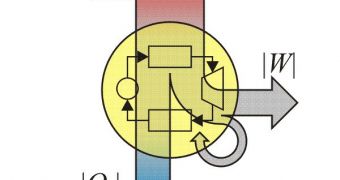Experts at NXP Semiconductors, in the Netherlands, announce that they have finally managed to achieve one of the most elusive goals of modern physics, namely to produce a heat engine that functions at the microscopic scale. Heat engines are among the most important devices our society and civilization rely upon. Their job is to transform heat into mechanical work, which can then be used to power up vehicles or for any other purpose. As heat is circulated through these engines, they set gas in motion, expanding it and powering our tools, trains, ships, cars, and so on, Technology Review reports.
Being able to create smaller heat engines than the ones available today could bring about a host of innovations, and could allow for very small gadgets to be powered in the same way cars are. But, until now, the smallest heat engine around had a volume of about 10^7 cubic micrometers. That all changed with the recent announcement by the NXP team, which revealed that the new engine it created had a volume of just 0.5 cubic micrometers. This basically means that it's seven orders of magnitude smaller than the previous smallest one. The science group at Semiconductors was led by Peter Steeneke.
The design of the new heat engine is revolutionary. It consists primarily of a bar of piezoelectric material, as this stuff is known to respond to mechanical deformations by producing electric potential. The bar itself either expands or contracts when an alternating current is applied, due to the piezoelectric effect. The bar can additionally be made to expand or contract by circulating an additional DC current through it at the same time. The timing of when each of the currents is applied is critical. If the right frequency is established, then the mechanical displacement of the bar is amplified naturally, via a resonance effect. The engine can then be placed to work, pushing and pulling stuff around.
But the possible applications for this device are amazing. The team reveals that, when this thermodynamic cycle is reversed, the piezoelectric bar can act as either a heat pump or refrigerator. In the near-term, the second ability could come in very handy. This heat engine may be placed as an insulating material around computer chips, pumping out heat, and keeping microprocessors, or other transistor-laden silicon boards, at a correct working temperature. As for the future of the new heat engine, “It remains to be seen whether they can ever compete with biological or artificial molecular motors on the microscale,” Steeneke reveals.

 14 DAY TRIAL //
14 DAY TRIAL //